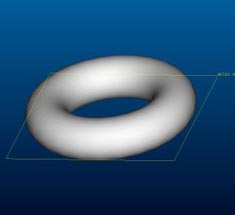
Inner Tube
View animation - 93 Kb
Description
Behavioral Modeling is used in this example to solve a buoyancy problem for an inner tube design. The objective is to determine the location of the waterline which describes the depth at which the inner tube will float.
Analysis features are created to capture the density of the inner tube and the volume of the submerged portion, as well as a relation which describes buoyancy through the mass difference between the inner tube and the mass of the displaced water at an assumed water line position. A feasibility study is then performed to reduce the mass difference to zero, thereby determining the actual waterline position, by varying the assumed floating depth of the inner tube.
Ease of design exploration is illustrated by changing the density of the inner tube and showing the position of the waterline changes automatically after rerunning the feasibility study and regenerating.
Practical applications of this example extend to the design of floats, buoys, or watercraft. Without Behavioral Modeling the designer must attempt to determine a solution through time consuming iterative techniques.
